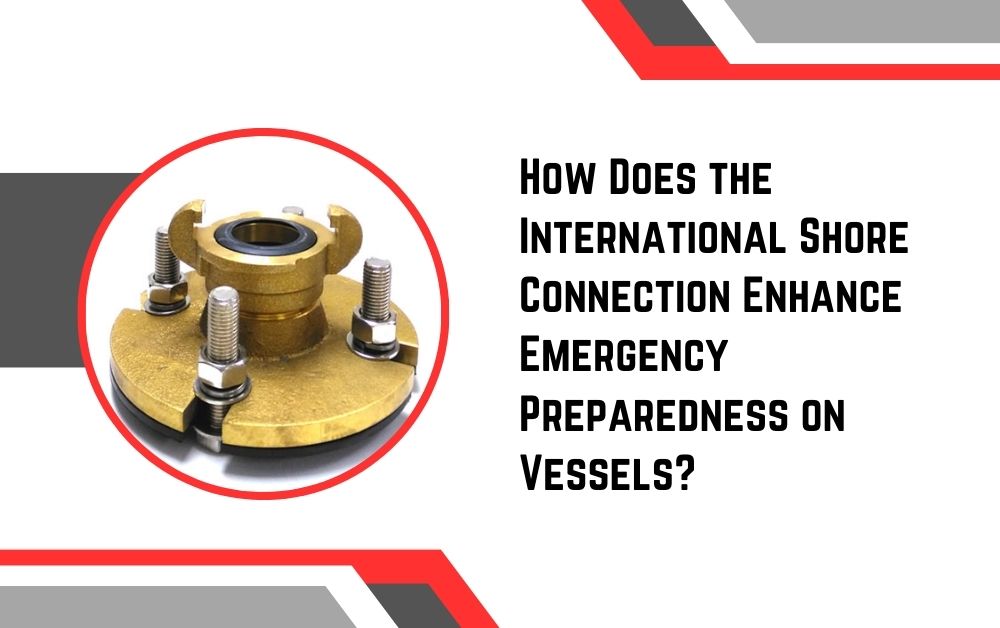One important tool that plays a significant role in emergency readiness is the International Shore Connection (ISC). This connection, which allows a ship to access shore-based firefighting resources, is a vital part of a vessel’s fire safety and overall emergency response system. In this blog, we will explore how the International Shore Connection works, why it’s essential for ships, and how it enhances emergency preparedness on vessels.
Understanding the International Shore Connection
What Is an International Shore Connection?
The International Shore Connection (ISC) is a standardized fitting that enables a ship to connect to a shore-based fire hydrant or firefighting system. It is designed to provide ships with access to additional water resources from the shore in case of onboard emergencies, particularly fires.
Key Features of an ISC:
- Standardized Design: The ISC is created to meet international standards, ensuring compatibility with various ports around the world.
- Quick Access: It provides a reliable means to connect to firefighting resources onshore, especially useful in emergencies when onboard resources may be limited.
How the International Shore Connection Works
The ISC functions as an adapter that connects the ship’s fire hydrants with shore-based water sources. This connection is commonly used when the ship is docked at port and needs additional water supply to handle fire emergencies.
Key Components:
- Coupling: The ISC includes a coupling that matches the standard port fittings, ensuring compatibility.
- Valve: The ISC is equipped with a valve that controls the flow of water from the shore to the ship.
- Hose Connection: A hose connects the shore’s water supply directly to the ship’s firefighting system.
Why Is the International Shore Connection Essential?
Enhanced Firefighting Capabilities
One of the primary functions of the ISC is to provide ships with a steady and potentially unlimited water supply from shore, enhancing their firefighting abilities.
Fire Response Advantages:
- Extended Water Supply: Ships have a limited water capacity onboard, which may not be sufficient for large fires. The ISC allows access to the shore’s firefighting resources to supplement onboard systems.
- Efficient Fire Control: By connecting to shore-based water, the ship’s crew can respond to fires more effectively, especially if the fire threatens critical areas of the vessel.
Compliance with Safety Regulations
International maritime laws require vessels to have the necessary equipment for firefighting and emergency preparedness, and the ISC is a part of these requirements.
Regulatory Standards:
- SOLAS Requirements: The International Convention for the Safety of Life at Sea (SOLAS) mandates that vessels carry an ISC to meet fire safety standards.
- Port State Control: Many port authorities include ISC checks during inspections to ensure that vessels comply with safety standards.
How the International Shore Connection Boosts Emergency Preparedness
Quick and Reliable Emergency Response
The ISC is designed for rapid deployment, making it a crucial asset in emergency situations. Having this connection onboard allows the crew to act quickly without waiting for specialized firefighting equipment.
Speed and Efficiency in Action:
- Immediate Access: In an emergency, the ISC allows a fast connection to shore resources, reducing response time.
- Ease of Use: The standardized design means that crew members can quickly attach the connection without needing specialized tools or additional setup.
Reducing the Risk of Escalating Emergencies
By providing access to a reliable water supply from shore, the ISC can help contain fires that might otherwise escalate and threaten the safety of the vessel and those onboard.
Controlling Emergencies:
- Preventing Fire Spread: The ISC enables effective firefighting efforts, helping to contain the fire and prevent it from spreading to other areas of the ship.
- Minimizing Damage: Controlling fires quickly helps reduce potential damage to the vessel, equipment, and cargo, ultimately protecting valuable assets.
Supporting Crew and Passenger Safety
Protecting Lives Onboard
One of the ISC’s most vital roles is safeguarding the lives of crew members and passengers during a fire emergency. The connection ensures that the crew has the resources to respond to fires quickly and effectively.
Key Safety Benefits:
- Reduced Fire Risks: The ISC minimizes the risks posed by fires, which are among the most dangerous threats on a ship.
- Enhanced Crew Preparedness: Knowing that they have access to additional firefighting resources helps crew members feel more prepared and focused during emergencies.
Allowing for Effective Evacuation
In cases where a fire poses a serious risk, having immediate access to firefighting resources through the ISC can help create safe evacuation paths, allowing passengers and crew to exit the ship safely.
Evacuation Support:
- Creating Safe Zones: Firefighting efforts using shore-based resources can help contain the fire, creating safer zones for evacuation.
- Time to Organize: Quick access to firefighting supplies can buy time, allowing the crew to organize safe and orderly evacuations.
Maintaining the ISC for Optimal Preparedness
Regular Maintenance and Inspections
To ensure the ISC is functional when needed, ships must conduct regular inspections and maintenance. Proper maintenance ensures that all components are in working order and meet international standards.
Maintenance Requirements:
- Visual Inspections: Regularly check the ISC for signs of wear, corrosion, or damage.
- Functional Testing: Perform routine tests to ensure the coupling, valve, and hose connection work as expected.
Training Crew on ISC Use
Training is essential for ensuring the crew is familiar with the ISC and knows how to use it in emergencies. Routine drills and training sessions prepare the crew to handle emergencies efficiently and with confidence.
Training Practices:
- Regular Drills: Incorporate ISC use in regular fire and emergency drills to build muscle memory for the crew.
- Hands-On Practice: Allow crew members to practice setting up the ISC connection with shore-based hydrants, especially when docked at different ports.
The Global Impact of International Shore Connections

Standardization Across Ports
The ISC is a standardized device, ensuring that ships can connect to shore firefighting systems across various ports worldwide. This global standardization simplifies emergency response for ships traveling internationally.
Benefits of Standardization:
- Uniform Equipment: The ISC’s standard design eliminates compatibility issues between different ports, ensuring readiness wherever a ship docks.
- Enhanced Cooperation: Ports and ships can work together effectively during emergencies, knowing that equipment standards are consistent.
Supporting Environmental Safety
Fires on ships not only threaten human lives and cargo but can also have severe environmental consequences. By allowing for quick firefighting response, the ISC helps protect against environmental damage from uncontrolled fires and potential hazardous spills.
Environmental Protection:
- Reducing Pollution Risks: Controlling fires quickly reduces the risk of hazardous materials entering the water or surrounding ecosystems.
- Minimizing Environmental Impact: Effective firefighting helps prevent incidents that could lead to spills, leaks, and long-lasting environmental damage.
Conclusion
The International Shore Connection is an invaluable tool for enhancing emergency preparedness on vessels. By providing a standardized, reliable way to connect with shore-based firefighting resources, the ISC improves safety for both crew and passengers. It also ensures regulatory compliance, supports environmental safety, and allows for a quicker and more effective response during emergencies.
Whether docked at a busy port or a remote terminal, vessels equipped with an ISC are better prepared to handle emergencies and protect lives, assets, and the environment. As a crucial component of modern maritime safety, the International Shore Connection exemplifies the importance of collaboration between ships and ports worldwide, ensuring that vessels can access the resources needed to respond swiftly and effectively in critical situations.
Note:- To read more articles visit on bloggingleads.



